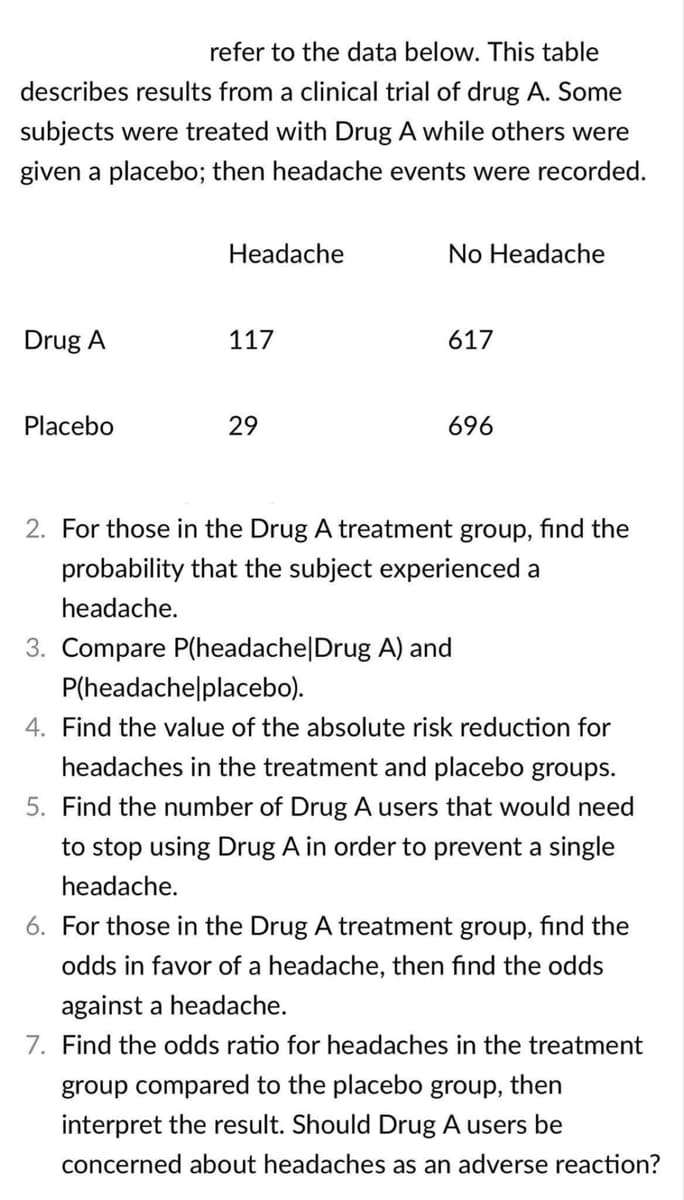refer to the data below. This table describes results from a clinical trial of drug A. Some subjects were treated with Drug A while others were given a placebo; then headache events were recorded. Headache No Headache Drug A 117 617 Placebo 29 696 2. For those in the Drug A treatment group, find the probability that the subject experienced a headache. 3. Compare P(headache|Drug A) and P(headachelplacebo). 4. Find the value of the absolute risk reduction for headaches in the treatment and placebo groups. 5. Find the number of Drug A users that would need to stop using Drug A in order to prevent a single headache. 6. For those in the Drug A treatment group, find the odds in favor of a headache, then fınd the odds against a headache. 7. Find the odds ratio for headaches in the treatment group compared to the placebo group, then interpret the result. Should Drug A users be concerned about headaches as an adverse reaction?
refer to the data below. This table describes results from a clinical trial of drug A. Some subjects were treated with Drug A while others were given a placebo; then headache events were recorded. Headache No Headache Drug A 117 617 Placebo 29 696 2. For those in the Drug A treatment group, find the probability that the subject experienced a headache. 3. Compare P(headache|Drug A) and P(headachelplacebo). 4. Find the value of the absolute risk reduction for headaches in the treatment and placebo groups. 5. Find the number of Drug A users that would need to stop using Drug A in order to prevent a single headache. 6. For those in the Drug A treatment group, find the odds in favor of a headache, then fınd the odds against a headache. 7. Find the odds ratio for headaches in the treatment group compared to the placebo group, then interpret the result. Should Drug A users be concerned about headaches as an adverse reaction?
Glencoe Algebra 1, Student Edition, 9780079039897, 0079039898, 2018
18th Edition
ISBN:9780079039897
Author:Carter
Publisher:Carter
Chapter10: Statistics
Section10.6: Summarizing Categorical Data
Problem 27PPS
Related questions
Topic Video
Question

Transcribed Image Text:refer to the data below. This table
describes results from a clinical trial of drug A. Some
subjects were treated with Drug A while others were
given a placebo; then headache events were recorded.
Headache
No Headache
Drug A
117
617
Placebo
29
696
2. For those in the Drug A treatment group, find the
probability that the subject experienced a
headache.
3. Compare P(headache|Drug A) and
P(headachelplacebo).
4. Find the value of the absolute risk reduction for
headaches in the treatment and placebo groups.
5. Find the number of Drug A users that would need
to stop using Drug A in order to prevent a single
headache.
6. For those in the Drug A treatment group, find the
odds in favor of a headache, then find the odds
against a headache.
7. Find the odds ratio for headaches in the treatment
group compared to the placebo group, then
interpret the result. Should Drug A users be
concerned about headaches as an adverse reaction?
Expert Solution
This question has been solved!
Explore an expertly crafted, step-by-step solution for a thorough understanding of key concepts.
This is a popular solution!
Trending now
This is a popular solution!
Step by step
Solved in 4 steps

Knowledge Booster
Learn more about
Need a deep-dive on the concept behind this application? Look no further. Learn more about this topic, statistics and related others by exploring similar questions and additional content below.Recommended textbooks for you

Glencoe Algebra 1, Student Edition, 9780079039897…
Algebra
ISBN:
9780079039897
Author:
Carter
Publisher:
McGraw Hill

Glencoe Algebra 1, Student Edition, 9780079039897…
Algebra
ISBN:
9780079039897
Author:
Carter
Publisher:
McGraw Hill